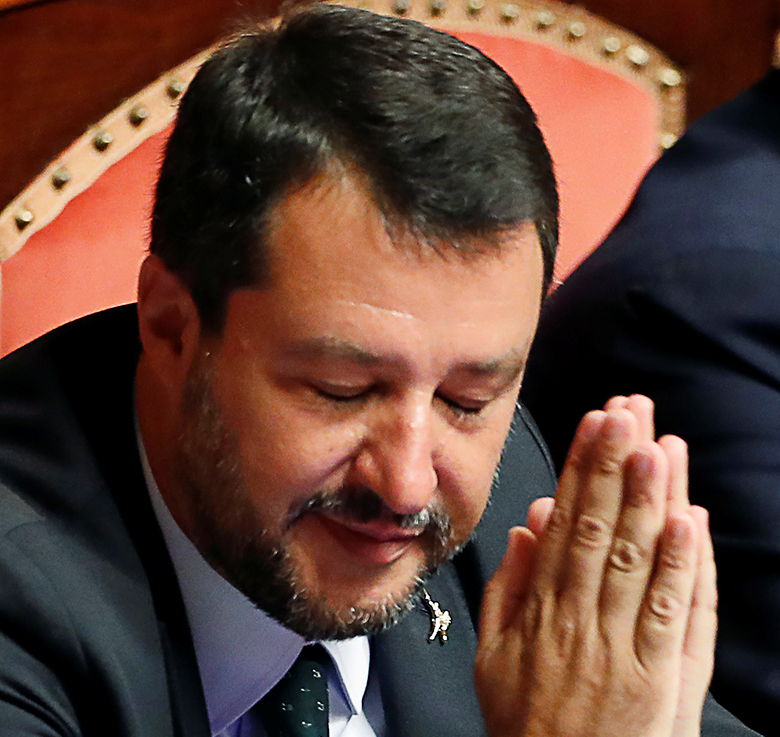Wing and a prayer: Matteo Salvini’s gambit backfired, but he could still be ‘the worst scenario’
Coalition governments in Italy are invariably risky endeavours, and so it proved on August 8 when Matteo Salvini, the leader of the right-wing anti-immigration party League, withdrew his support from the coalition with Five Star Movement (M5S) in the hope of triggering snap elections.
A political crisis had been brewing with Italian analysts flagging the possibility by downgrading their risk scores earlier in the year.
Tensions were heightened when political differences came to the fore handling immigration and agreeing to a proposed high-speed rail link to France.
Salvini had had enough. Having seen his party overtake M5S in the polls, now was his chance to trigger a snap poll in the hope of taking on the role of prime minister once and for all.
However, his gambit has spectacularly backfired.
Apart from the fact League’s popularity seems to have peaked, an unlikely marriage of convenience between M5S and the opposition centre-left Democratic Party (PD) is about to put the technocrat PM Giuseppe Conte back at the helm – assuming strong parliamentary backing can be found.
The immediate political crisis is resolved, and in that case fiscal discipline and relations with the EU are likely to improve, supporting the euro and Italian yields, although much of that is already factored in.
However, Italy’s problems will be far from fixed.
That fact is underlined by experts contributing to Euromoney’s survey still eyeing Italy’s investor prospects with a good deal of caution, despite its banks addressing the non-performing loans problem with gusto.
Italy ranks a lowly 42nd out of 186 countries, below Spain and Portugal on a similar risk score to Malaysia and China, and few analysts anticipate a sudden improvement in fortunes:
Economy on the rocks
The reason for that is clear.
The political crisis could not have occurred at a worse time, with the economy flatlining for more than a year and business confidence remaining low through July with manufacturing sentiment declining.
Not one of Italy’s economic risk indicators has registered any improvement in Euromoney’s survey this year, with the growth outlook, unemployment and government finances all scoring less than half the maximum points available.
Euro Zone Barometer, a monthly survey of independent economists, predicts anaemic growth of just 0.1% this year and 0.5% in 2020, with the unemployment rate remaining above 10%, urging more reforms.
Meanwhile, the manufacturing sector purchasing managers’ index has stayed below 50, indicating contraction for the past 10 months, highlighting how Italy’s weak economy has become the norm.
And the fact Germany is on the cusp of recession with a no-deal Brexit looming are hardly conducive to any near-term improvement.
Plus, any reluctance to implement measures required to address the fiscal deficit will likely see the general government imbalance (EU measure) widen to 2.5% of GDP in 2019 from 2.1% in 2018, according to Euro Zone Barometer, before increasing to 3.3% in 2020.
All of which risks pushing Italy’s gross debt burden higher, to 134% of GDP by the end of next year.
Consistently negative
Independent sovereign risk expert Norbert Gaillard is one of many Euromoney survey contributors who has remained consistently negative on Italy, notably on its debt trajectory.
Gaillard believes that even with a new government formed, the prospect of social and industrial unrest cannot be ignored, with Salvini’s allies calling on supporters to take to the streets in protest.
Moreover, it is hard to envisage an M5S-PD pairing lasting, given the former’s anti-establishment and euro-sceptic leanings, and opposition to high-speed rail. PD is more supportive of EU membership and also favours fiscal stimulus using large investments to bolster the economy.
Gaillard believes the probability of elections before, say, June 2020 is quite low.
Still, the two parties are bitter rivals and are sure to spark their own political conflict, and if they part before the next scheduled elections in 2023 it could then hand Salvini a majority, creating an outcome that would be “the worst scenario”, Gaillard warns.
League has talked before about introducing an alternative currency to pay off Italy’s debts, possibly as a stepping-stone to taking Italy out of the eurozone, which Salvini craves.
Even if that seems fanciful, Italy owes more than two trillion euros and has some large exposures to European banks, notably to France, and with Salvini wedded to an expensive fiscal stimulus programme, a League government would invariably spook the markets again.
“There would be tensions with the EU; the euro would slip below $1.10 and the yields of Italy’s T-bonds would soar, despite a possible new quantitative-easing programme by the ECB,” says Gaillard.
Italy has, so far, done little to assuage the EU or the markets that it is treating the debt problem seriously.
The new government might change all that, clearly.
However, with the economy consistently negative, it is tempting to push the problem down the line and that only increases the risk of another, potentially larger negative market reaction.
Indeed, Italy’s risk score suggests any market rally might prove short-lived. It’s up to the new government to provide a convincing argument it can put Italy back on track.
NOTE: Do you want to trade at forex professionally? trade with the help of our forex robot developed by our programmers.
Signal2forex reviews


 Signal2forex.com - Best Forex robots and signals
Signal2forex.com - Best Forex robots and signals




